Europe’s quaint country of Luxembourg, often affectionately referred to as the “Grand Duchy,” is a blend of historical grandeur and modern vitality. With its medieval castles, lush landscapes, and rich cultural heritage, this small yet dynamic country offers a wealth of experiences for travelers.
From the enchanting Vianden Castle to the vibrant streets of Luxembourg City, there’s something to captivate every visitor, myself included! Exploring the best sights to see and things to do in Luxembourg, we’ll uncover hidden gems and iconic landmarks that define this must-visit destination.

Fun Luxembourg Attractions and the Best Things to Do
LUXEMBOURG CITY
1. Bock and the City Casements (Casemates du Bock)
The Casemates du Bock, often referred to simply as “Bock,” are a vast network of underground tunnels and chambers (over 17 km in total length!) that wind beneath the historical city of Luxembourg. They were originally constructed as part of the city’s fortifications in the 17th century, and were expanded and modified over the centuries.
The casemates served as a vital part of Luxembourg’s defenses during numerous wars and sieges, and played a key role in the city’s reputation as the “Gibraltar of the North.” Today, the Bock Casemates are a popular tourist attraction, offering visitors a unique glimpse into Luxembourg’s military history.






2. Wander around the Old Quarter of Luxembourg City
The Ville Haute of Luxembourg City is a UNESCO World Heritage Site that is known for its beautifully preserved medieval and Renaissance architecture, charming cobblestone streets, and quaint squares. You can explore the many cafes, shops, and cultural landmarks, such as the Grand Ducal Palace, Notre-Dame Cathedral, and the Bock Casemates. For stunning views of the city and surrounding countryside, a visit to the Chemin de la Corniche is a must!




3. Take in the View from the Pfaffenthal Panoramic Elevator
The Pfaffenthal Panoramic Elevator is a glass elevator that connects the Ville Haute (Upper Town) to the Pfaffenthal district below in the Alzette River valley. This 75-meter architectural marvel offers great views of the city’s topography, including the Alzette River, the city’s historic bridges, and the modern skyline. It’s also a convenient and visually striking way to traverse the city and appreciate its layered landscapes.
Edited: This iconic attraction isn’t just for tourists; it doubles as a convenient and visually stunning way of travel through the city’s levels, providing a unique perspective on its layered beauty.


4. Choose a Bottle from the Longest Wine List in the World
Chiggeri, a renowned restaurant and wine bar in Luxembourg City, holds the Guinness World Record for the longest wine list in the world. With an extensive collection of over 2,000 wines from around the globe, it’s a wine enthusiast’s paradise.
You can browse their impressive selection, expertly curated by sommeliers, and choose the perfect bottle to complement your dining experience. Chiggeri’s wine list features a wide range of wines, from vintages dating back to the 19th century to new releases from up-and-coming winemakers. Whether you’re a seasoned wine connoisseur or just starting to explore the world of wine, Chiggeri’s wine list is sure to have something for everyone.
5. Visit Palais Grand-Ducal (Grand Ducal Palace)
The Grand Ducal Palace in Luxembourg City is an architectural gem that serves as the official residence of the Grand Duke of Luxembourg. While the palace’s interior is not open to the public, you can appreciate its stunning neoclassical façade and witness the changing of the guard ceremony during the summer months. Guided tours are also available during the summer, allowing you to explore the palace’s grand halls and learn about its historical significance.


6. Visit the Grand Duke Jean Museum of Modern Art (Museum of Modern Art)
Designed by renowned architect I. M. Pei, the Grand Duke Jean Museum of Modern Art (or Mudam) houses an impressive collection of over 700 modern and contemporary artworks from both Luxembourg and international artists, including works by Andy Warhol, Thomas Struth, and Bruce Nauman. Its striking architecture and innovative exhibitions make it a must-visit destination for art enthusiasts, offering a window into Luxembourg’s vibrant cultural scene.
7. Walk along the Walls of the Corniche (Chemin de la Corniche)
Often called “Europe’s most beautiful balcony,” the 2-km Chemin de la Corniche offers a scenic stroll along the historic walls of Luxembourg City. As you wander this elevated promenade, you’ll be treated to views of the Alzette River, the Grund district, and the city’s charming old town. You’ll also pass by a number of historical fortifications and monuments, such as the Bock Casemates and the Pont Adolphe. Definitely a must-add to your list of Luxembourg attractions to visit!
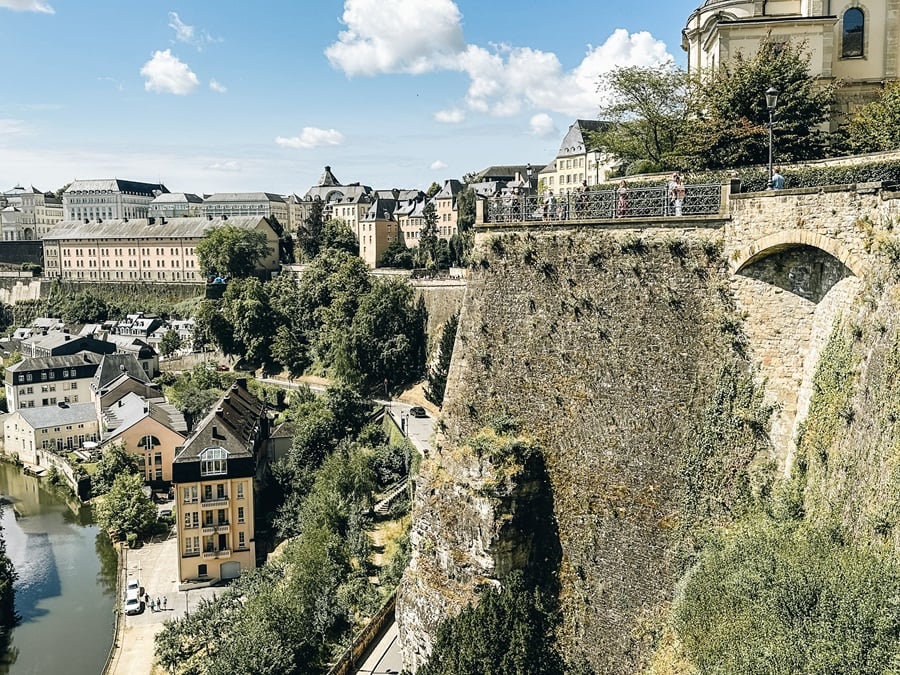

8. Walk across Pont Adolphe
The 153-meter-long Pont Adolphe is an iconic architectural landmark in Luxembourg City that connects the Ville Haute (Upper Town) to the railway station district, offering a picturesque path across the Pétrusse Valley. The double-decked arch bridge’s main arch has a span of 85 meters, making it one of the largest stone arches in the world at the time of its construction.
Aside from being a popular tourist destination, it is also used by locals on a daily basis. The bridge is a pedestrian and cyclist bridge, and it is also used by public transportation.
9. See a Concert at the Philharmonic of Luxembourg
The Philharmonic of Luxembourg (also known as the Philharmonie) is a world-class venue renowned for its exceptional acoustics and innovative architecture. Attending a concert here is a cultural experience like no other.
From classical to jazz to contemporary, the Philharmonie hosts a diverse range of musical events that will transport you to another world.
“Be sure to check out their website for any upcoming shows you might like. They also host free guided tours of the building every Saturday (reservation required).
10. Walk Across Passerelle Viaduc
Curious about a picturesque stroll in Luxembourg City? Passerelle Viaduc, a charming 290-meter-long pedestrian bridge, invites you to take a leisurely walk across the Pétrusse Valley. Also known as the Old Bridge, it offers not only a convenient pathway from the city center but also a great place to take a break from sightseeing and enjoy the scenery. Plus, it makes for a perfect spot for taking photos of the city.
11. See the Monument of Remembrance (Golden Lady)
The Monument of Remembrance, often referred to as the “Golden Lady” or “Gëlle Fra,” is an iconic war memorial situated in Constitution Square at Ville Haute. It commemorates the Luxembourgers who perished during World War I, II and the Korean War.
The monument consists of a 21-meter-tall granite obelisk topped by a gilded bronze statue of Nike, the Greek goddess of victory. The statue holds a laurel wreath in her outstretched hand. At the base of the obelisk are two bronze figures representing Luxembourger soldiers who died in the wars.


12. Visit Museum Dräi Eechelen
Located in the restored Fort Thüngen, the Museum Dräi Eechelen offers a captivating journey through Luxembourg’s military history. The museum got its name from the Luxembourgish word Dräi Eechelen (meaning “three acorns”), representing the three rounded turrets that survived demolition back in 1867 as part of the Treaty of London.
The Museum Dräi Eechelen has over 600 artifacts in its permanent exhibition. These artifacts include weapons, uniforms, equipment, and other objects that tell the story of Luxembourg’s military history from the Middle Ages to the present day.


13. Visit the Historic Neighborhood of Grund in Luxembourg City
The Grund district (also known as the Old Quarter) is a great place to visit for anyone interested in Luxembourg’s history, culture, and food. Nestled along the banks of the Alzette River, this UNESCO World Heritage site is one of the oldest parts of the city, dating back to the 14th century, and is known for its narrow alleys, medieval buildings, and riverside ambiance.
Some of the things you can see here include the 17th century Neumünster Abbey, which houses private works by the Luxembourg sculptor Lucien Wercollier, and the National Museum of Natural History, whose notable holdings include the 8000 year old skeleton called the Loschbour man.
In addition to its historical and cultural attractions, the Grund district is also home to a number of restaurants, cafes, and shops. One such restaurant is Mosconi, a one Michelin star restaurant which specializes in different kinds of pasta.


14. Have a Business Lunch
Luxembourg City offers a range of dining options for business lunches. From upscale restaurants to cozy bistros, you can choose a venue that suits your preferences and agenda. A business lunch in Luxembourg features a prix fixe menu with a fixed price and typically 3 courses, combining business discussions with culinary delights and experiencing the city’s vibrant dining scene.
Some of the places you can check out include the L’Annexe (popular French bistro at the heart of the city), Restaurant Clairefontaine (pricey but elegant French dining with a four-course lunch menu), and the Grand Cafe (popular steakhouse known for its friendly service and lively atmosphere.)
15. Follow a Self-Guided Walking Path
Exploring Luxembourg City on foot is a delightful experience, and the Wenzel Circular Walk is a popular choice. This self-guided historical trail leads you through the old town’s winding streets, passing by significant landmarks like the Corniche and Bock promontory and providing insights into the city’s rich history.
Another one you can check out is the Vauban Circular Walk, a 4.5 km loop that takes you through the historic fortifications of Luxembourg City, such as the Bock Promontory, Three Towers, and Fort Niedergrünewald.
16. Visit Notre Dame Cathedral
The Notre Dame Cathedral is the only cathedral in Luxembourg, and it is a popular tourist destination. Originally a Jesuit church dating back to the 17th century, it seamlessly blends late Gothic elegance with hints of Renaissance flair. The cathedral was enlarged in the 20th century, and now has three towers.
The cathedral is home to a number of important religious artifacts, including the statue of the Consoler of the Afflicted, who is the patron saint of the city and the country. The cathedral also contains the tombs of several Grand Dukes of Luxembourg.


17. Admire the National Museum of History and Art (Nationalmusée um Fëschmaart)
The National Museum of History and Art in Luxembourg (Musée National d’Histoire et d’Art, MNHA) is the largest museum in the country dedicated to displaying artworks and artifacts from all epochs of Luxembourg history. You can find it in Fishmarket, the historic heart of the city, in the Ville Haute quarter.
The museum’s collection includes over 300,000 objects across its ten floors, covering various disciplines, including artifacts from the Stone Age to the Middle Ages, coins and medals, contemporary art, and many more. They also have a library with over 25,000 volumes, as well as a documentation center and a photo library.
- Stop by Place Guillaume II
Often referred to as “Knuedler,” Place Guillaume II is Luxembourg City’s main square and a bustling hub of activity. It is named after William II, Grand Duke of Luxembourg and King of the Netherlands, who reigned from 1840 to 1849. You can see his equestrian statue overlooking the square to the east.
Surrounded by historic buildings, cafes, and shops, the Knuedler is the ideal place to soak in the city’s atmosphere. The square often hosts events (like the Rock um Knuedler rock concert), markets, and festivals, making it a dynamic focal point for both locals and visitors.


19. Pont Grande-Duchesse Charlotte
Often called the “Red Bridge,” the Pont Grande-Duchesse Charlotte is an iconic suspension bridge spanning the Pétrusse Valley. Its vibrant red color and elegant design make it a distinctive architectural landmark in Luxembourg City. Crossing this bridge offers not only a practical route but also scenic views of the surrounding landscapes, providing a memorable experience as you explore the city.
CENTRAL LUXEMBOURG
20. Explore the Valley of the Seven Castles
If you’re interested in history and medieval architecture, this one’s for you. The Valley of the Seven Castles is a region in Luxembourg known for its abundance of historical fortresses. As the name suggests, this valley is home to not just one but seven enchanting castles, each with its own unique character and history:
- Mersch
- Schoenfels
- Hollenfels (open to the public)
- Ansembourg Castle
- New Castle of Ansembourg (open to the public)
- Septfontaines
- Koerich Castle (open to the public)
The most convenient way to visit the castles is by car, which takes you on a 27-km scenic ride from Mersch to Koerich. If you’re up for a challenge, you can go on a hike and follow the 37-km National Footpath, which also connects the castles along the valley.
P.S. You can visit one of the tourist centers for a copy of the map (ideally at Mersch or Koerich, since they are the first/last castles on the way.)
NORTH LUXEMBOURG
21. Visit Bourscheid Castle
Bourscheid Castle is the largest castle in Luxembourg, and is also one of the most impressive. This medieval fortress, with origins dating back to the 11th century, occupies a commanding position atop a hill overlooking the Sûre River. Its strategic location was pivotal in safeguarding the region during turbulent times.
During the 19th century, the castle was abandoned and fell into disrepair. However, it has been partially restored in recent years, and is now open to the public. Even in its incomplete state, the castle’s ruins are still impressive, and they offer stunning views of the surrounding countryside.
The castle is made up of two main enclosures, each surrounded by its own wall. The inner enclosure is the oldest part of the castle, and it contains the keep, the chapel, and other buildings. The outer enclosure was added in the 14th century, and it contains a number of towers.




22. Visit Vianden Castle
Vianden Castle is a medieval castle located in the Our Valley in the north of Luxembourg. Its well-preserved architecture and rich history amidst a breathtaking setting make it one of the most popular Luxembourg attractions. The castle was built in the 11th century and has been expanded and modified over the centuries.
Take a step back in time as you explore its furnished rooms, walk along the ramparts, and take in the views of the Our Valley below. The castle also hosts various exhibitions, offering insights into its rich past.
P.S. For the best views of the Our Valley and the castle, I suggest taking the chairlift (the only one in the Grand Duchy of Luxembourg,) which takes you from Vianden to a hilltop beside the castle.
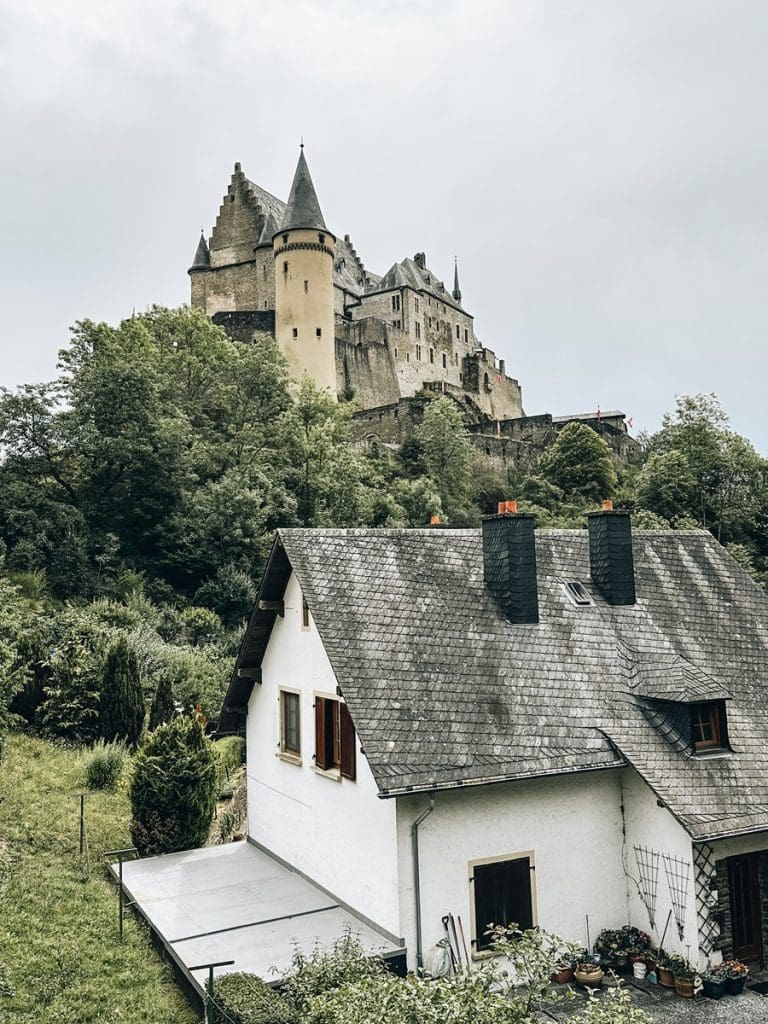



EAST LUXEMBOURG
23. Explore Hohllay Caves
Venture deep into Luxembourg’s geological wonders by exploring the Hohllay Caves. This series of underground caves in Berdorf got its name due to its hollowed out parts, most of which were man-made back when it was mined for its rock during medieval times. The caves are made up of sandstone and limestone, and they are home to a variety of stalactites and stalagmites. A guided tour of the caves is available for visitors, which lasts about an hour.


24. Hike the Mullerthal Trail
The Mullerthal Trail is a 112-kilometer hiking trail that winds through the Mullerthal region, Luxembourg’s Little Switzerland. The trail is known for its scenic sandstone formations, which include natural bridges, arches, and pillars.
The trail mainly consists of three loops, which is further divided into several sections and can be hiked in either direction. Some of the most popular paths include the Berdorf Loop and the challenging Fred Welter Trail.
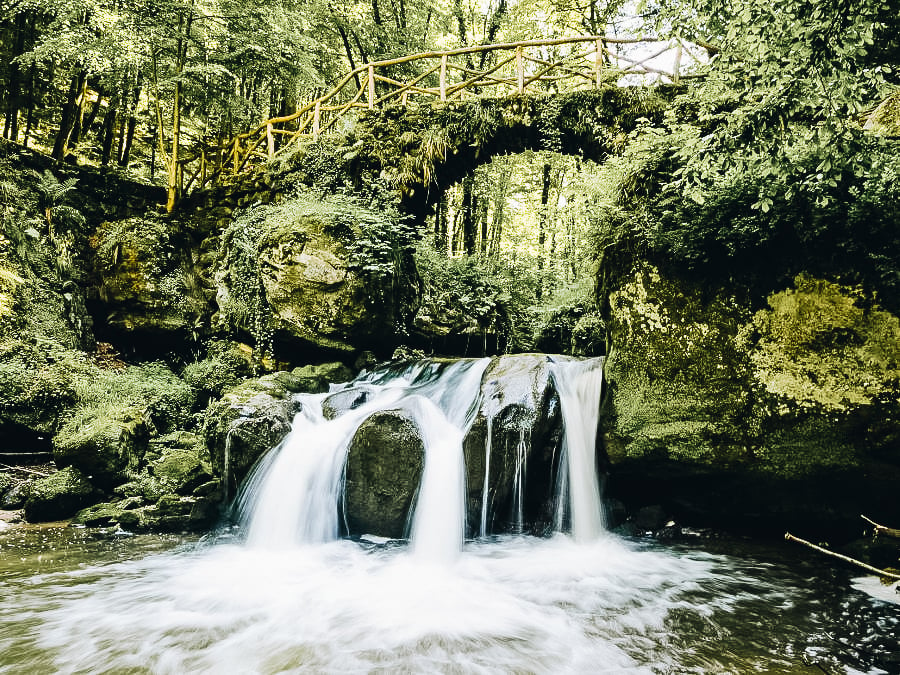

25. Medieval Castle Beaufort
The Castle Beaufort is actually two castles, a medieval fortress (which is in ruins) and a Renaissance château, located in the commune of Beaufort in eastern Luxembourg. The medieval fortress was built in the 11th century, and was expanded and renovated several times over the centuries. The Renaissance château was built in the 17th century and was designed by Jean Baron de Beck, then Lord of Beaufort.
While you can visit both castles, the château is only open with a guided tour (where you can also get the chance to taste their Cassero liqueur at the end.)


26. Luxembourg’s Oldest City, Visit the town of Echternach
Echternach is a town located in the east of Luxembourg. And yes, it is the oldest town in the country, with a rich history dating back to the Roman era. Situated along the Sûre River, it offers a charming old town replete with medieval architecture and narrow streets.
The town’s market square (Place du Marche) is home to some of the must-see sights in Echternach, which include the Town Hall, the Denzelt courthouse, and the Cross of Justice. Echternach is also known for its annual Hopping Procession (which takes place on a Christian holiday called Whit Tuesday), a UNESCO-recognized tradition.


27. Visit Abbey of Echternach (Echternach Benedictine Abbey)
Also known as the Echternach Benedictine Abbey, it is a prominent religious and cultural site in Luxembourg, founded in 698 AD by Saint Willibrord. Many visitors flock here, especially during the annual Hopping Procession, where a mass is held as the final part of the event.
The abbey has a beautiful and ornate facade made of sandstone and limestone, decorated with different sculptures and carvings. Inside, you can explore the cloisters and gardens, visit the tomb of St. Willibrord, or be amazed by their collection of artifacts, which include a 1,200-year-old manuscript called the Echternach Gospels.
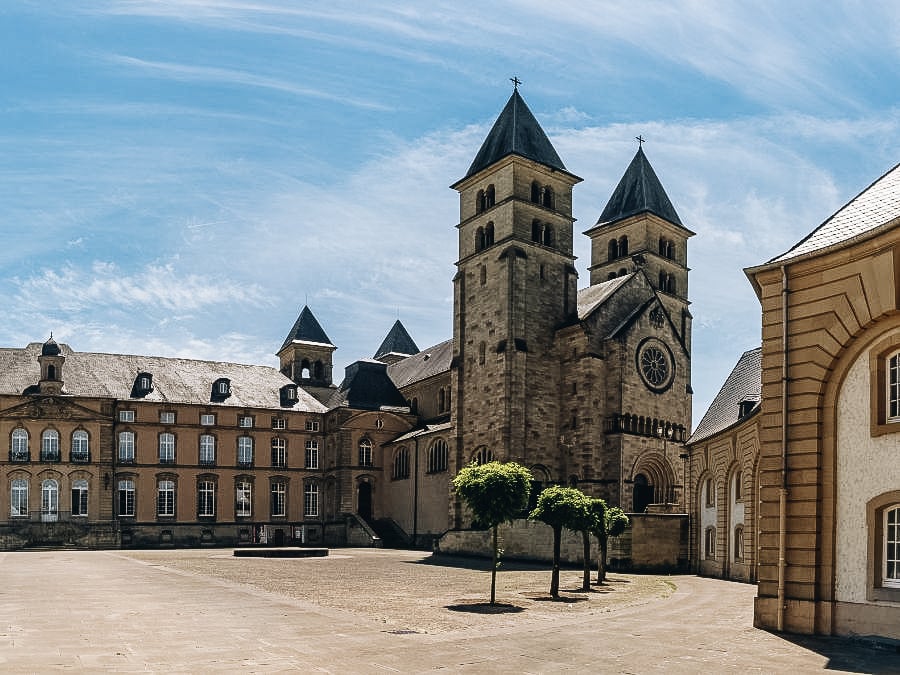

28. Explore the City of Larochette
Larochette is a town located in the south of Luxembourg. It is best known for its medieval castle ruins, which are perched on a hill overlooking the town. Additionally, Larochette is an excellent starting point for hikes and outdoor adventures in the Mullerthal region (such as this one), making it an ideal destination for both history enthusiasts and nature lovers.
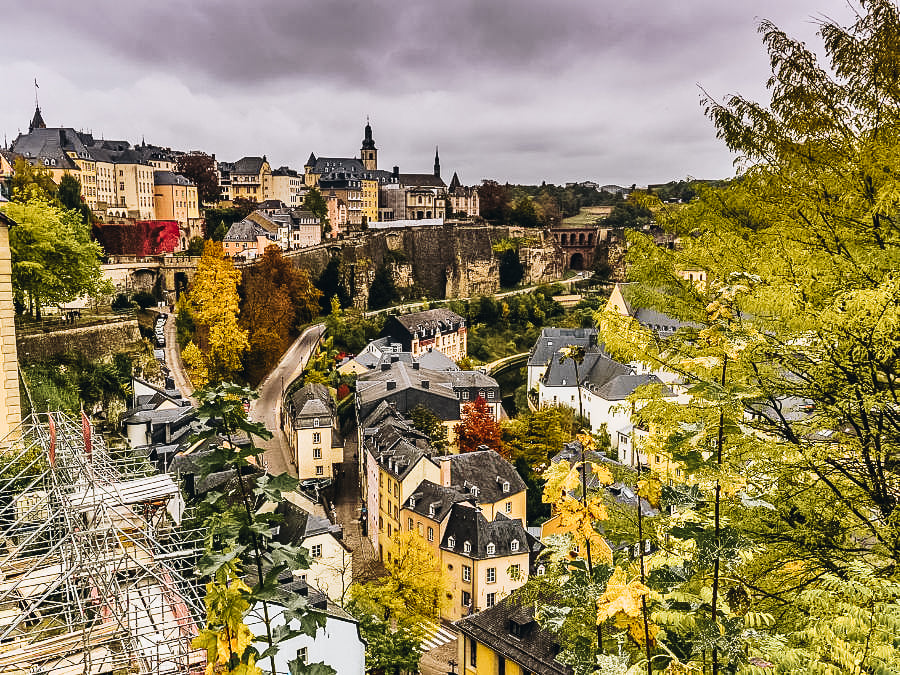

29. Go Wine Tasting in Luxembourg’s Moselle Wine Region
What better way to get a taste of what Luxembourg’s wines have to offer than a visit to its famous Moselle Wine Region? Best known for their Riesling wines, it is home to a number of vineyards and wineries who continue to showcase the country’s winemaking heritage.
Caves St Martin SA is a renowned winery located in Remich, Luxembourg. Established in 1919, it has a long-standing tradition of producing high-quality wines, particularly sparkling wines and crémants. You can learn about their winemaking process and, of course, have the opportunity to taste some of the exceptional wines on a guided tour of their cellars.
Located in the wine-rich region of Schengen, Caves Henri Ruppert is another prominent winery in Luxembourg. Established in 1904, they offer you a chance to explore its historic cellars and sample a wide range of local wines, including their Gëlle Fra and Pinot Noir.
For a unique beverage experience, consider a visit to Ramborn Cider Co. in Born. This craft cider producer is known for its artisanal approach to cider making, using locally sourced apples and traditional methods.
You can tour the orchards and production facilities, gain insights into the cider-making process, and enjoy tastings of their various cider offerings (their CM Blend is a must-try!)
30. Explore Berdorf
A tranquil village in the heart of the Mullerthal region, Berdorf invites you to embrace its natural charm. Surrounded by lush forests and unique rock formations, Berdorf is a paradise for hikers and outdoor enthusiasts.
Its famous rock formations, like the Teufelsschlucht (Devil’s Gorge) and the Hohllay Caves, provide opportunities for exploration and adventure. The village’s serene atmosphere and proximity to the Mullerthal Trail make it an ideal starting point for outdoor escapades in Luxembourg’s “Little Switzerland.”


NORTH WEST LUXEMBOURG
31. Take a Solar Boat on Upper-Sûre Lake
The Upper-Sûre Lake is a beautiful lake in the Ardennes region of Luxembourg. It is also the largest lake in the country, making it a popular spot for water activities like swimming, boating, and fishing.
However, if you’re looking for a unique way to experience the lake, I suggest taking a solar boat tour. These tours are emission-free and quiet, making them a great way to enjoy the peace and quiet of the lake.
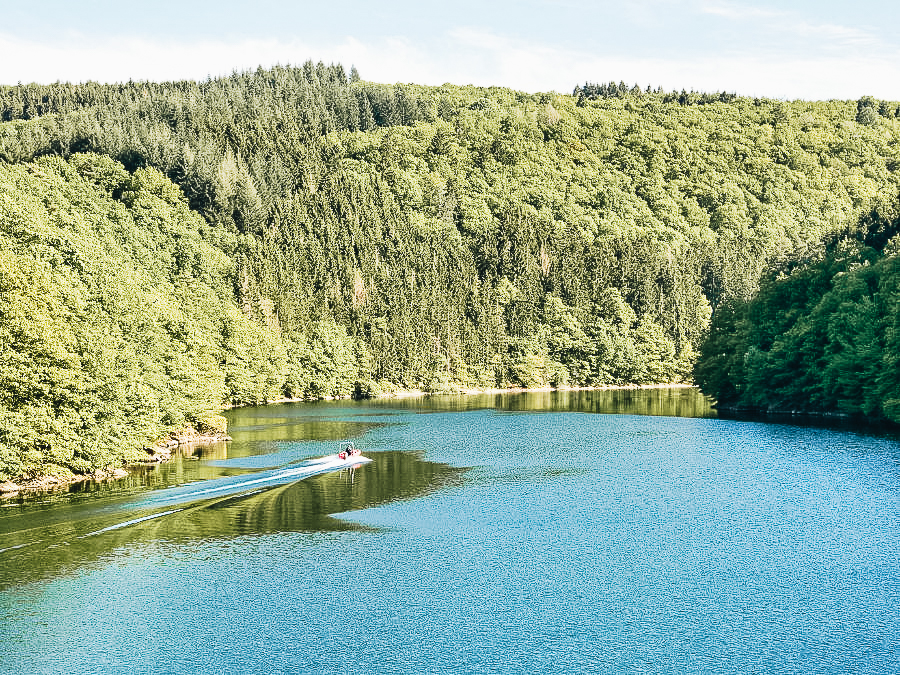

32. Make Your Way to Wiltz
Wiltz is a charming town surrounded by forests and mountains in the Ardennes region of Luxembourg. It is best known for its medieval castle, narrow streets, and half-timbered houses.
There are many things to see and do in Wiltz, including exploring the charming old town with its medieval architecture, hiking in the surrounding countryside, and visiting the Wiltz Castle, which now houses a cultural center. Wiltz is also home to a number of festivals and events throughout the year, like the Festival de Wiltz, making it a great place to visit any time of year.


33. The Luxembourg Ardennes
The Luxembourg Ardennes is a mountainous region in the north of Luxembourg. This pristine wilderness is characterized by dense forests, rolling hills, and meandering rivers, making it the ideal destination for hiking, cycling, and exploring nature.
The Ardennes is also home to a number of historical sites, including the Battle of the Bulge Museum and the Vianden Castle. If you are looking for a place with a beautiful and rugged natural setting, then the Luxembourg Ardennes is the perfect one for you.


WEST LUXEMBOURG
34. Ride the Train at Minett Park
Minett Park Fond-de-Gras, situated in Luxembourg’s commune of Differdange, is an expansive open-air museum spanning 100 hectares. It explores the region’s mining history, featuring key elements like the village of Lasauvage (built for miners and their families), the former open-pit mine “Giele Botter” turned nature reserve, and the ancient Celtic oppidum of Titelberg. The park houses industrial structures like a power station, railway station, and grocery store (Epicerie Victor Binck).
One of the things you can do here is riding one of the park’s trains, the “Minièresbunn” mining train and Train 1900. The Minièresbunn takes you to different industrial sights, starting from Fond-de-Gras and travels through the former open-pit mine “Giele Botter” to Saulnes, France. For Train 1900, the train ride runs on the former “Mining Line” between Fond-de-Gras and Pétange, and features a more rural scenery with hills and forests along the way.
35. Kahler Luxembourg – The Farming Village With Graffiti Murals
The quaint farming village of Kahler is probably one of the most unique places to visit in Luxembourg. While it is known for its beautiful rural scenery and hiking trails, it is becoming well known in recent years for its striking graffiti murals, transforming traditional farm buildings and walls into vibrant, colorful masterpieces.
Some of these include “The Racer,” which features a snail with car parts on its back reminiscent of Pixar’s Turbo, and “L’Orchestra,” featuring different animals in costumes playing instruments. How many of these murals can you find?
36. Useldange
Useldange is a commune in Luxembourg that boasts a rich historical heritage. The focal point of this charming village is the Useldange Castle, a medieval fortress dating back to the 12th century. Although mainly in ruins, there are still plenty of things to see inside, like the cemetery, museum, and vegetable garden. You can even climb the tower for panoramic views of Useldange.
During the summer, don’t miss their annual Medieval Festival, where people are dressed in medieval garbs and reenact what life was back then. Aside from the castle ruins, the village is also home to the cute “Mushroom Hotels” of Péitche Lauer Hotel and EcoLodges.


SOUTH LUXEMBOURG
37. Relax at the Mondorf-les-Bains Thermal Bath
The Mondorf-les-Bains Thermal Bath is a premier wellness destination in Luxembourg. This luxurious spa complex is renowned for its thermal pools (which are fed by natural hot springs) and therapeutic treatments. The healing properties of the thermal waters have attracted visitors for centuries.
Here, you can immerse yourself in warm, mineral-rich pools known for their soothing effects on muscles and joints. The spa also offers a range of wellness services, including massages and facials, ensuring a serene and rejuvenating experience.
38. Stroll around Parc Merveilleux
When it comes to animals and nature, Parc Merveilleux in Bettembourg is a wonderful, family-friendly place to visit with the kids. As the only park in the country, Parc Merveilleux is many things all rolled into one: an amusement park, an animal sanctuary, a recreational area, and a whimsical fairytale haven.
The animal park houses almost 200 animal species from five continents, from red pandas to penguins to kangaroos and more (some of which you can hand-feed and even pet!) Various attractions are also available for children, such as playgrounds, fairytale cottages, mini-train, and mini-golf.
P.S. The park is open from late March to early October, and the entrance fee is 14 euros for adults and 9 euros for children.
39. Take in the Nature at Biodiversum – Nature Reserve Haff Reimech
Biodiversum is a futuristic nature conservation center located on an artificial island in the Haff Reimech nature reserve in Luxembourg. Adjacent to the Moselle River, the center provides a vital habitat for a diverse range of flora and fauna. Inside, you’ll find interactive exhibitions on the area’s history, geology, biodiversity and environmental protection.
It’s also a top birding spot, home to 80% of Luxembourg’s bird species, including Great Reed Warblers and Little Bitterns. Boardwalks and observation platforms allow visitors to explore the wetlands and marshes while minimizing their ecological impact.
GENERAL LUXEMBOURG
40. Try Luxembourgish Food
If you’re looking for a new culinary adventure, why not try Luxembourgish food? This small European country has a rich and diverse cuisine that reflects its history and culture.
Some of the most popular dishes include Judd mat Gaardebounen, a hearty stew of smoked pork and broad beans; Gromperekichelcher, crispy potato pancakes served with applesauce; Ardennes Ham, a cured and smoked ham that is often eaten with bread and mustard; and Kachkeis Cheese, a soft and creamy cheese that is spread on bread or melted over potatoes.
41. Dine out at a Michelin-starred restaurant
Since we’re already talking about food, we might as well go all in! Dining out at a Michelin-starred restaurant is probably one of the best things you can do in Luxembourg, with nine restaurants with one or more Michelin stars offering a variety of cuisines and atmospheres.
Whether you prefer classic French, modern fusion, or local specialties, you can find a place that suits your taste and budget. Some of the most popular options are Mosconi, Ma Langue Sourit, and La Distillerie, but you can also discover hidden gems in the countryside or the city center.
42. Spend a Day in Germany’s Oldest City, Trier
Looking for a day trip from Luxembourg? You might want to visit Trier. Nestled near Luxembourg’s border, it holds the distinction of being Germany’s oldest city, dating back over 2,000 years. Trier is rich in history and culture, and has many attractions to explore.
One of the most famous landmarks is the Porta Nigra (or Porta, as referred to by the locals,) a massive Roman stone gate that dates back to the 2nd century AD. You can also admire the Trier Cathedral, a stunning example of Romanesque and Gothic architecture that houses a holy relic: the Seamless Robe of Jesus.
Trier is also known for its wine production, so don’t miss the opportunity to taste some local varieties at one of the many wine bars or restaurants in the city.


The Grand Duchy beckons travelers with its rich tapestry of history and contemporary charm. From its medieval fortresses to its dynamic capital, this nation delivers a diverse array of attractions and experiences. Whether you’re enchanted by ancient castles or captivated by vibrant city life, there are plenty of things to do in Luxembourg for every kind of traveler.
Best Tips for Visiting LUXEMBOURG
How to Get to Luxembourg: Luxembourg Airport or also known as Luxembourg Findel Airport (LUX / ELLX) is a major hub and most airlines will fly into it. You can easily check for the best fare deals at Skyscanner, which also has the option to choose ‘cheapest month’ as the departure to find the lowest priced dates to fly to your destination. From the airport to the city center, you can take a bus or a train.
Getting Around: Driving in a new destination can be a bit of a challenge, but if you choose to rent a car, RentalCars.com has great deals. If you are not renting a car, there are plenty of other options. Bus, taxi and trams are available all over the city, plus you can also hire a bike to ride around the city.
Best Time to Visit Luxembourg: Luxembourg is a great place to visit throughout the year! But if you’re looking for the most delightful weather, you might want to consider planning your trip for May, June, or September. These months are typically a treat, with the late spring and late summer vibes making your visit extra special. Luxembourg boasts a temperate climate, so you won’t have to worry about any extreme weather here. Summers are pleasantly warm, and winters are comfortably cool.
Where to Stay in Luxembourg: It’s best to stay near the city center, public transportation or the area that you will be spending the most time in. Sofitel Luxembourg Europe is a great choice in the Kirchberg. For something on the less expensive side, try Mercure Luxembourg Off Kirchberg located in Luxembourg. For a hotel with a little more extravagance, book a room at the Hotel Le Place d’Armes. Or search some great deals on hotels of your choice at Booking.com. If you’re looking for more of a home atmosphere (or are traveling with a group of people), head over to VRBO that has houses, apartments and even just a room for rent in every price range.
Best Tours in Luxembourg: You can find some of the top tours at Get Your Guide or Viator, and here are some of the top ones. tours:
Universal Adapter: Your American plugged equipment will need an adapter. I use the Celtic Universal Adapter, which has brought me around the world with no problems.
This post may contain affiliate links. If you make a purchase through my links, I earn a commission that helps to keep this blog running—at no extra cost to you. For more information read my full disclosure.
More Things to Do in Europe
Zurich Switzerland Bucket List: 35 Best Things to Do
Geneva Switzerland Bucket List: 40+ Best Things to Do
The Catacombs of Paris: History and Tips for Visiting
See the Carrières de Lumières Art Show in the South of France




